Cyberpunk Cinema: Valuing The Virtual
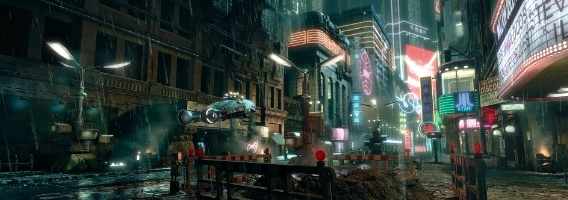
Through analysis of the field of cyberpunk film, we see that its themes have become increasingly relevant to our current contextual world. This is through cyberpunk’s representation of emotion and social order of the organic and the artificial. Many would connect the words ‘cyber’ and ‘punk’ to inventive associations of the chaotic, the futuristic and the robotic. The genre enables such terms to collide in collaboration, and formulate something that provokes audiences to question what defines the human condition.
Cyberpunk manifests in several forms – literature, video games, art, comics, history, cinema – but is considered more than simply a category of creation or an era. Cyberpunk films display a philosophy; a place where science and technology combine with reality, existence, knowledge, reason and values. While it is true that cyberpunk represents different things to different people, there is a common thread that ties certain ideas together.
The world of cyberpunk emphasises the height of technology, pushing the norms by questioning whether technology assists life, or is a form of life. The word itself, cyberpunk, is a hybrid of cybernetics (the science of structures and systems) and punk (the attitude and ideology of defying hierarchy and rebelling against the system). This implies that where a sense of order is intended, there becomes a sense of disorder. Cyberpunk blurs together both sides of the black and the white, enabling us to look into the shades of grey between what is natural and artificial; the organic versus the mechanical; reality versus virtuality.
There is a mutual attitude and outlook among the characterisation of cyberpunk. The contextual world of the cyberpunk setting is headed toward moral, environmental and social decay. The almighty corporate system calls the shots, where the rich are becoming richer, the poor are becoming helpless, and life as they know it is becoming desperate. The work of cyberpunk is always from the perspective of the oppressed, whom is working to survive underneath the domination of power structures that run the cyberpunked near-future. The punk’s of this world generally take on a “mess with me and you’ll regret it” attitude here, as the cyberpunk way of life is accompanied with the severe issues of corruption, privacy, intrusion and deception at large.
The mise-en-scène of cyberpunk film emphasises science fiction as the catalyst for its visual themes. Cyberpunk aesthetic presents a dim and tenacious vision of the realistic prospect of our future, though to the extreme. Mega enterprises override the urban space, with grimy cityscapes illustrating the morality of drugs and crime that fill these spaces. Individualism is prohibited, as freedom and the right to expression is suppressed to conformity and mass abidance. There is a very clear undertone of oriental influence in the visual sensibilities of cyberpunk film, in which those of Asian background have become the primary survivors of this decaying world. These factors are the very imagery focused in cyberpunk art, presenting the dystopian world seen in many film interpretations. This spurs viewers to watch in looming fear and wonder.
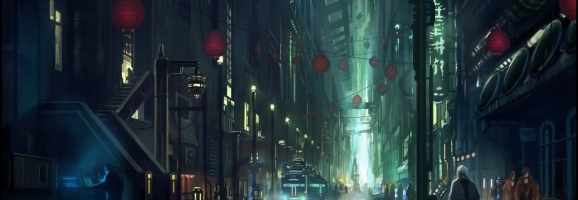
As 21st century inhabitants with technology always within reach, we ironically connect to the integral theme of the cyberpunk genre. This theme is the human engagement with conviction and empathy towards the artificial. Humans have digital machinery with such technology capable of designing, constructing, revolutionising, inventing cures, and doing the thinking for us. This signifies that technology is not merely for everyday use at our convenience, but to aid in continuing the evolution of mankind. Essentially, it is machines making machines. A machine, after all, is an apparatus with the intelligence and energy to carry out a function. Natural life was the first machine, and cyberpunk film allows audiences to contemplate the relationship between organic (us) and synthetic machines.
The following titles display differing representations of cyberpunk influence. Some may already be on your radar; some may be long forgotten; and some titles are the unseen texts of the genre. These films provide valid ways of discussing and appreciating the world of cyberpunk.
THX-1138 (1971)
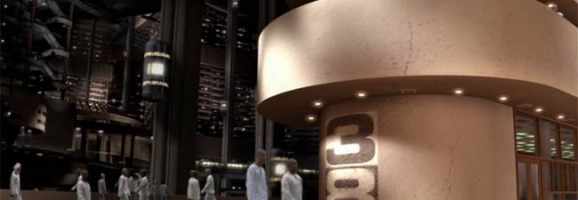
THX-1138 is the small-known wonder directed by the great George Lucas, Star Wars extraordinaire. The THX-1138 film presents an eery underground realm in an undefined time of the future, where its characters have had their identities removed: all names are replaced with codes, and each individual’s head is permanently shaved. The humanity of this cyberpunk world is void as medication and television brainwashing acts to remove all human emotions.
The film’s characteristics strongly parallel to the themes of cyberpunk, as the overshadow of mind control officers strip the inhabitants of their freedom and right to individualism. Furthermore, the battles of love and desire surface between primary characters THX-1138 and LUH-3417, as both of them stop taking the medication that rids them of their human feelings. Robert Duvall plays THX-1138, and his love interest LUH-3417 is played by Maggie McOmie. The film’s viewers are motivated to contemplate the consequences of their forbidden relationship, and highlights question around the hierarchy’s suppression of intimacy as an organic human trait in the preference to control emotionless robots.
There is also a high degree of cyberpunk visuals in the film, as much of the story and context is driven through its visual representation of colour and scale. The film is dominated with the scheme of a dirty yellow-brown and black, together illustrating the colour combination of hazard and caution. Everything inside the corporation in which they work, and the machinery surrounding them is grand, though sinister and intimidating. These visual factors add to the film’s overall message of the abuse of power, personal intrusion and emotional decay. Not at all a bad film for a low budget film using ’70s CGI. Well worth a watch.
A Clockwork Orange (1971)

This classic, based on the Anthony Burgess novel, has to be among one of the most recognisable films of its time, with such surrealist imagery and its treatment of violence, sex and modification. Though, many viewers are yet to recognise the film’s connection to the cyberpunk qualities, through its undeniably high correlation to cyberpunk themes and archetypal cyberpunk visuals. The film was written and directed by Stanley Kubrick, and introduces Alex De Large (played by Malcom McDowell) in a futuristic England. Large’s street raids and gang involvement has him kill a woman, where he is then convicted and sentenced to 40 years jail time. Large has the Ludovico treatment used on him here, an experimental method where he is injected with serum and exposed to video footage of rape and violence – unbeknown to the effect that the serum will have. Dr Brodsky says during Large’s first treatment:
Very soon now, the drug will cause the subject to experience a deathlike paralysis together with deep feelings of terror and helplessness. One of our early test subjects described it as being like death. A sense of stifling or drowning. At this period we have found that the subject will make his most rewarding associations between his catastrophic experience, environment and the violence he sees.
It is here that the theme of free will versus society’s programming is prominent, invoking a sense of the cyberpunk struggles of personal intrusion and the use of human life as the experimental play toy. Brodsky’s use of Large for the Ludovico treatment emphasises how he is bring used as a pawn for political gains: “He [Alex De Large] can be the most potent weapon imaginable to ensure the government is not returned in the election. The government’s big boast, sir, is the way they have dealt with crime: Recruiting young roughs into the police, proposing will-sapping techniques of conditioning.”
The cyber characteristics of this theme can be noted, despite the film’s 1971 context and hence a lesser reliance on computer technology as of yet. The punk of the film could be mistaken for a modern film interpretation; a commendable mix of gang wars, youth revolt, underground drug scenes and the force of behavioural change against rights to freedom. A Clockwork Orange is a bit of a demented and frightening depiction of the cyberpunk aesthetic – and so a demented and frightening depiction of the future.
Bladerunner (1982)
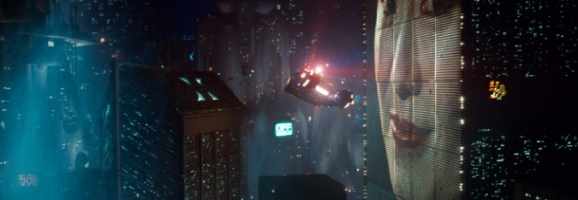
The name itself, Bladerunner, associates with danger, fast pacing, escape and fear. This film embodies all of these things, and with a cyberpunk edge. Ridley Scott’s near-future noir film features Eldon Tyrell as the leading force behind Tyrell Corporations, the mega enterprise taking over dystopian Los Angeles with human creations, called replicants. Replicants are what’s known as the synthetic humans of Bladerunner; Tyrell’s latest mass creation being from the Nexus 6 generation. Immediately, the cyberpunk undertones are dominant in the reign of Tyrell, who is the the force that yields power over society by infiltrating these replicants’ minds. Tyrell, here, signifies how the masses of this world are tamed and used as puppets to explore new realms of technological control. It is here that we note the technology in use and corporate power being abused are the answers to the society’s downfall.
Though originally based on the book Do Androids Dream of Electric Sheep? by Philip K. Dick, the film’s winning aspect is the tension between organic and mechanical life. We learn that Tyrell’s replicants have a 4 year life-span before they “retire” (die), and Tyrell believes implanting the replicants with certain memories will create a cushion, allowing for emotional development, and making them more controllable. The replicants have solely been designed and produced for human use, which toys with the idea of artificial intelligence being developed so as to satisfy the needs and desires of natural beings. Serving as useful machines as protection, pleasure slaves and labour, the replicants do become self aware as they grow “older”, developing feelings, their own personality and the longing for more time before their expiry. This free will and desire for fellow company, human experiences and an extended life facilitates the conundrum for viewers to contemplate if the replicants’ ability to recognise this constitutes them as being real, living things. The question raised here: what does it mean to be real? The film explores this and concludes with the bottom line: to be able to feel is to be alive. Replicant Roy Batty’s ‘Tears in Rain’ scene at the close of the film is the final token in exploring this idea. With a dramatic flying dove (that no one ever saw enter the scene) and all, Batty’s final scene really is a remarkable way to pose this topic to the audience.
As it can be seen, Bladerunner‘s imbedded ideas of suppression, knowledge, intrusion, human emotion and social decay are ticking all of cyberpunk’s boxes, making the film worthy of a second look in 21st century film.
Tron (1982)
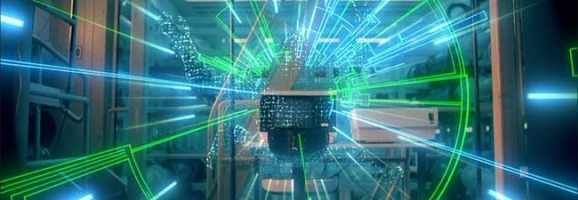
This one is a bit of an interesting pick, being the first film to put extensive 3D CGI to use – the monumental ‘Light Cycle’ sequence being known to committed movie buffs of this underground genre. Tron can be argued as being pre-cyberpunk, however its thrills of human and computer connection, corporate greed, the exploration of knowledge and access to information, along with the sense of dystopia, equals a piece of cinema that has a high correlation to the cyberpunk characteristics.
Written and directed by Steven Lisberger, Tron follows a computer programmer Kevin Flynn (played by Jeff Bridges) who, having worked for ENCOM, has his programs stolen by Ed Dillinger (David Warner) and passes them off as his own. In attempt to go back to the corporation to retrieve them, Flynn gets sucked into a game that he initially developed. The adventure proceeds, as Flynn must “play the game” to overcome the contestants and the Master Control Program (voiced by Warner) for the chance to escape virtuality for reality again. The films reads as quite a male-friendly one, with plenty of tactics and chase scenes to be the star of any man cave.
The players in the game’s fantasy realm deliberately mirror their human users. This residual self image is therefore the theme that made Tron the catalyst for future films dealing with the battles of reality in the cyberpunk world – your digital self appears the same on the inside as well as outside of your virtual reality. This point bridges the gap between what is credibly real and what has been created; presenting another interpretation that knocks on the ‘organic vs. mechanical’ door once again.
Visually, Tron incorporates the classic features of the cyber-atmosphere, with striking lines, neons and a uniform colour palette that dominates the entirety of the film. With the additional layer of a soundtrack loaded with synthesizers, there is a high degree of cyberpunk visual and audio sensibility in these aspects, which compliments Tron‘s high correlation to cyberpunk themes.
One thing to point out: if you give this film a go, mind the outdated computer-speak. The year was 1982, and its original contextual audience wouldn’t have batted an eyelid. And surprise, it’s by Walt Disney Productions.
Battle Angel (1993)

Battle Angel is an film adaption of Yukito Kishiro’s Manga series Battle Angel Alita. There were two volumes adapted from the series, Rusty Angel and Tears Of An Angel, which allow Battle Angel as an anime film to transcend its original Japanese context. Director Hiroshi Fukutomi does well to thread his ideas of the cyberpunk perspective through the film’s themes and visual features.
The film resides in the future’s floating city of Zalem, after society has suffered a collapse. Inhabitants live in Zalem, and also live under it in Scrap Iron City, where they live off the scraps that Zalem expels. In charge of the running of Scrap Iron City is the corporation known as the Factory. The Factory plays the role of dominance accordingly to the cyberpunk genre by sourcing products for exclusive use in Zalem, and organising the roles of the people beneath them (physically and figuratively). A hierarchy here is immediately established, revealing cyberpunk’s power to the dreaded system; the rich are climbing higher and the poor are reduced to suffering.
Cyborg life and the rampant interference of technology means that many of the humans of Battle Angel are bordering non-human boundaries: their brain being the only part of them that remains from their initial host body. Begging, scabbing and theft signifies the decay of the societal system run by the Factory – theft not limited to food or shelter, but human body parts. Get ready for the gore – despite the animated nature of the film – as backbones are highly prized… even if that means thieving them from a living host body. It all happens here.
As the story follows a cyborg doctor sourcing body parts for a female head with its brain in-tact, the film tends to get a little weird. But given the chance, the eery turns to sad and hopeful – fleshing out to be a description of a very well made and intelligent depiction of the universal cyberpunk struggle to find our place, connect with others, opt for moral choices, and to find purpose. Props to Japanese anime for enlightening my understanding of cyberpunk in non-traditional forms.
Dark City (1998)
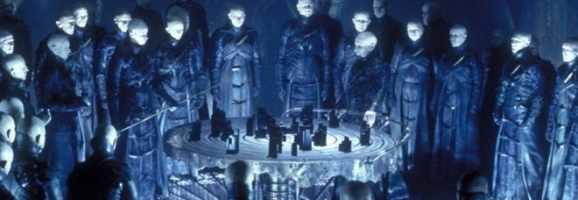
Not nearly enough people have seen or discussed Dark City as a shining interpretation of the cyberpunk repertoire. Dark City is a one that certainly nods to cyberpunk’s roots of film noir, with its dark and gritty visuals, dramatic lighting and gothic moods. The film’s suspense, treatment of humanity and value of memory are rather commendable attributes to its success. Dark City‘s depth of ideas really take it to the leaderboard of such tech-noir films that represent a valid voice for the cyberpunk perspective.
Alex Proyas co-wrote and directed the film, allowing it to exude valuable themes and creative visuals to carry the true cyberpunk aesthetic. The story has a complicated plot, weaving in the life of John Murdoch (Rufus Sewell) with that of the Strangers (extraterrestrial beings using corpses as their host bodies). The Strangers, in classic cyberpunk manner, meddle in time travel, pausing time, physically rearranging their city, as well as altering human identities and memories. As Murdoch is on the run from them, the Strangers are found to have a collective consciousness, a “mass mind”, and have been experimenting with humans to analyse their individuality to gain insight to assist their own race’s survival.
The warp of time, identity theft, Murdoch’s psychological struggle, and the repercussions of a cyber world with psychokinetic power, truly brings Proyas’ world to life. He has created an atmosphere where his characters romp in, and “viewers can get lost”, as discussed by James Berardinelli of ReelView. Berardinelli writes: “We don’t just coolly observe the bizarre, ever-changing skyline; we plunge into the city’s benighted depths, following the protagonist as he explores the secrets of this grim place where the sun never shines. Dark City has as stunning a visual texture as that of any movie that I’ve seen.” This will surely make you want to give this movie its chance.
The degree of cyberpunk visuals are clear as day and skilfully executed, though the true standout of the film is seen in how strongly the themes correlate to cyberpunk debates. The tampering – and transformation – of memory is focused on as the root of humanity. The Strangers, being the off-planet kind they are, engage in seeking what we’ve seen from alike cyberpunk tech-beings suffering in alienation; their wish to understand traditional humanity for the self-proclaimed desire to be, or experience, the act of being human. Proyas encircles these thoughts by clarifying what “we’re exploring in this film, is what it is that makes us who we are. And, when you strip an individual of his identity, is there some spark, some essence there that keeps them being human, gives them some sort of identity?” With the layers of ideas and detail in this film, it simply can’t be praised enough.
Cyber Wars (2004)
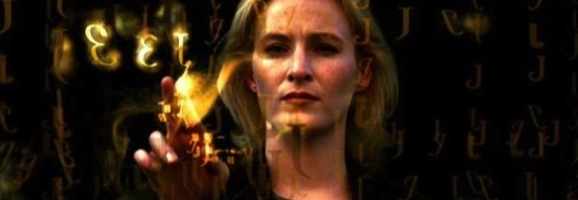
Cyber Wars, also known as Avatar and even Matrix Hunter, allows viewers a little more insight to the non-traditional understanding of good versus evil in the science fiction world. Being a Singaporean film, and also the island’s first sci-fi film at that, Cyber Wars can come across as to need a little more development with its characterisation and dialogue. However despite its low budget restraints, the film presents key cyberpunk ideas and a high degree of cyberpunk aesthetic. Kudos to the writer and director, Christopher Hatton and Jian Hong Kuo, in this sense.
Set in a sprawling futuristic metropolis, their entire life is connected through CyberLink, where audiences decipher is a system involving the internet crossed with cyberspace. CyberLink controls everything – communications, trade, finances. The city Sintawan is the hub for mega-corporations and therefore, CyberLink; emphasising personal agendas for financial gains, and ultimately corporate greed. Now, while many CyerLink users are legitimate and legal people, some have disguised their digital user identities through using SIMPLANTS, much like a fake ID. Bounty Hunters and Ident Police track down illegal users, though the story really heats up when comes a situation involving CyberLink, SIMPLANTS and a leader of a major corporation. Corruption at its best.
A diversity of cyberpunk musings have been included despite the film’s financial constraints, which are assets to creating the film’s credible world. Surveillance is disguised as mini-robots in the form of dragonflies, that record audio and visual, used for the projection of holograms. Holograms feature predominantly in the film, which are used to facilitate deceiving representations that appear real (like the fancy hotel). Holograms also act as an avatar, used when a man’s sickness limits his body to shut down, though allowing his mind to continue functioning through digital form. Furthermore, these hologram visuals may blow you away when you consider the small scale of the film, and hence what this film has been able to create. The film also features cyberpunk Ravers, that are gangs of digitally enhanced humans with brain implants, whom are linked to each other through electromagnetic pulses. Ravers have dodged their communication through CyberLink, and hence are anti-government and anti-system, in true punk style. Though importantly, we see the driving cyber-theme to the film is social engineering, which is treated like a game by the heads of the mega-corporations. The film questions if this ‘game’, which brings them wondrous wealth, is worth the end of their ultra-futuristic society.
Heard enough? Get watching.
Renaissance (2006)
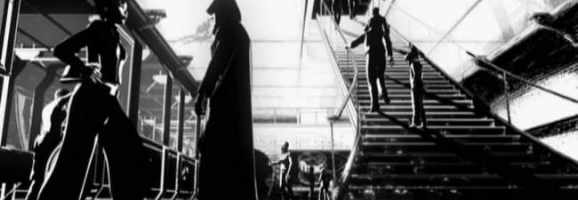
It’s the year 2054. Paris has grown in layers, and the emphasis between the rich and the poor as are divided as they’ve ever been. The Avalon Corporation rules the cityscape, even the Police are their servants. Welcome to Renaissance, a notable French animated black-and-white cyber-sci-fi.
The film is very noir-meets-cyberpunk, a great hybrid for contemporary enthusiasts. The story follows the hunt for a young, promising biogeneticist Ilona (Romala Garai) who has been kidnapped – the case striking a rather extreme and mysterious interest with the Avalon Corporation, leading company of control and surveillance. The film presents the hunt in the non-traditional sense of storytelling, as it jumps between key players throughout the duration of uncovering clues to Ilona’s disappearance. Renaissance spirals into a new realm of cyberpunk thrill when detective Barthélémy Karas (Daniel Craig) uncovers an even darker side to Avalon Corporations, and furthermore finds that the secret to immortality has been discovered, with ties leading back to the missing Ilona herself. They are discovering that the future of humanity could be at great risk if Ilona is found. Renaissance is written by Alexandre de La Patellière and Mathieu Delaporte, brought to life by director Christian Volckman.
The film’s correlation to cyberpunk themes in this sense are strong, as the lone player Ilona holds the answers to the humanity’s descent, all the while under the intruding eyes of the large conglomerate, Avalon. The theme of immortality is an important one, as we see the film’s consequence from challenging God’s position over humanity. This theme is more relevant than you may first believe; the equivalent of immortality is a reality that the 21st century is predicted to face within the next 50 years, from technology and healthcare potential. The issue lays in immortality’s ironic destruction of humanity; in which a time where life can be extended, and therefore controlled. With control comes ultimate power, as seen in the hands of the Avalon Corporation. If faced with this potential, will the possibility of immortality be evenly distributed or will this be a tool of domination, as depicted in Renaissance? The great debate edges closer and closer.
The cyberpunk-influenced animation and overall cinematography is both outstanding and innovative. As an all black-and-white film, the use of shadows are strong in highlighting the action points, and the use of grey, though sparingly, is used to depict changes in mood. The architecture of Renaissance provides great cyberpunk aesthetic, depicting the flawed and futuristic cityscape of Paris. A glassy transparency reveals walkways above and below the city’s roads, which adds to the film’s sleek, neo-noir ambience. There are large billboards in the film showing beautiful women praising the mega-corporation, in true cyberpunk style. Lastly, the use of science and technology is thought-proking and clever, such as the Holodeck sphere prison (where Ilona is kept), eye implants, pen-sized virtual computers and the interaction of holograms and their human counterparts. This is a film that definitely needs to be appreciated.
Honourable mentions of a more film mainstream selection that display the aesthetic, characterisation and themes of the cyberpunk genre include Alien, The Matrix, The Island, Dredd, The Terminator, Bicentennial Man, Robocop and Fifth Element.
It is clear that cyberpunk was the turning point in the world of science fiction. Cyberpunk takes on a myriad of themes and concepts, all of which have variables that make cyberpunk a hard genre to truly define. Where past sci-fi works have been extrapolated from a singular notion, cyberpunk has taken on the job of demonstrating how its themes aren’t developed in isolation, but are all deeply interconnected. Cleverly so, the concepts of the cyberpunk genre act as a mirror, reflecting the ongoing descent of morality, power and the environment that many are questioning, speculating and dreading for our future on Earth. We may not be experiencing the plight of acid rain, single-race supremacy, and memory control tactics, but cyberpunk is providing an outlet for us to consider the factors that are defining our current society, and how this can affect our future. Cyberpunk has facilitated a platform for more credible speculation.
What do you think? Leave a comment.











Really terrific and though provoking article Michelle. I’ve seen a number of films on your list but until now I didn’t understand the underlying Cyberpunk aesthetic. The reason that I was unaware of such themes was because I made the mistake of thinking that Cyberpunk is only a description of setting, not of ideas. Similar to Steampunk, I only associated the word with a certain kind of art design, not with the central idea that man’s greatest achievements could also lead to his downfall. It’s a frightening idea that seems like it could be getting closer and closer to fruition. Wally Pfister’s new picture Transcendence looks like it may deal with these themes in a contemporary setting so I am very interested in seeing it and I wonder what you’ll make of it. Again, this was a great article that helped me understand the true nature of the Cyberpunk genre.
P.S. Glad to see Dark City on the list!
P.S.S. Thanks for all the suggestions you’ve made for my articles 🙂
This is wonderful to hear, thanks so much August for your positive feedback.
P.S. Dark City deserved a spot!
P.S.S. My pleasure! I really enjoy editing, as you can tell by my novels that I write ha!
Two things: I’m curious if you’ve ever seen the film Alphaville. It’s sort of proto-cyberpunk, a film from Goddard, 1965. It might interest you. Also: have you ever considered the many instances of cyberpunk/cyborg analogies in trans theory? I’d be interested to see a film that explores the topic of transgender through a cyberpunk lens.
Great article!
I have never seen Alphaville (apologies!), but it sounds worthy of looking at. I haven’t considered that either, I’m open to the thought though unsure as to how that would be done. Has it been done before? I have no idea!
Thanks very much
I’m going to have to check one or two of these out. I’m more a reader than a watcher of SF genres, but these sound good.
Great to hear, the article was successful then! Thanks
Maybe this is not exactly ‘cyberpunk’ but ExistenZ is an awesome movie. It does the ‘reality-inside-reality’ thing in a far more interesting way than both The Matrix and Inception IMO (not that they were bad movies).
I need to see ExistenZ, haven’t before! Cheers
Cyberpunk is my favorite genre so happy to see this posted. More viewers should explore Cyberpunk; Robotic prothetics; Direct neural interface with computers and machines via a “jack”; Awesomeness.
Thanks for such positive feedback, it’s definitely an underrated genre that isn’t in the light all that often. I first learned about it in school, luckily enough!
(and now I’m in third year at Uni and still appreciating it!)
“Johnny Mnemonic” with Keanu Reeves. The whole movie was bloody cyberpunk.
I have never heard of it – there are too many that I haven’t seen. Thanks Nelms
I agree. Good suggestion Nelms.
All the films listed are between decent and great, but Renaissance…it just sucks. It sucks badly. The story is simplistic, the characters are transparent (specially the hero), the dialogues seem to have been written by me when I was 11, the visuals get boring really fast, and the final twist leaves no room for any interpretation.
Saying it sucks is a subjective view. There are plenty of areas where, objectively, it can be appeciated and praised 🙂
Metropolis has had great influences on the science fiction genre, or even just movie making in general. I always recommend friends to watch this first before delving into science fiction films…
I have never seen it, thanks for mentioning it.
Loved Bladerunner, but never real thought about the cyberpunk significance specifically. Great article.
It ticks many cyber-boxes! Thanks Austin.
I can’t believe I’m about to admit that I haven’t seen Bladerunner – putting it at the top of my list before I delve into any of the other recommendations here! Great article Michelle!
It is my favourite cyber-film, I would definitely recommend! I also studied it in my final year of high school, where I actually really understood it. Thanks so much!
Bladerunner is hugely influential on cyberpunk without actually quite being cyberpunk itself somehow.
With a more mainstream cast than most cyber films, it can be appreciated in the Hollywood sense while still having definite cyberpunk undertones. A win-win really, drawing on both sets of audiences
*in, not on!
Almost forgotten but ‘New Rose Hotel’ is good. It is based on a Gibson short story, stars Christopher Walken and Willem DaFoe, and isn’t everyone’s cup of tea, though I enjoyed it. It’s from the late 90s, so it may appear a little dated today.
You had me at Christopher Walken! Sounds sweet, right up my alley. I like 90s movies, despite the old use of CGI/basically everything. Thanks for your comment!
I think the Matrix is more transhumanist, honestly. It has definite cyberpunk aspects (computer hacking, dystopia, rouge operatives running from the authorities) but it is more upbeat about the potential of the human condition than “true” cyberpunk would be.
The Matrix is about rebels fighting a system. That’s pretty punk.
Cyberpunk doesn’t necessarily have to illustrate a bleak picture of future humanity, though just an interpretation of what it could develop into. The Matrix definitely displays “the aesthetic, characterisation and themes of the cyberpunk genre” like I wrote in the article, and like many of the films I discussed, also contains elements of other sub-genres of sci-fi and the like.
The Ghost in the Shell anime series is probably the best example of cyberpunk that I’ve ever seen.
I’ve never watched it, I’m new to anime, but thank you for your comment and suggestion 😀
A fine and very inspirational list… gonna have to delve deeper into this genre.
From the most to least CP:
Bladerunner
Ghost in the Shell
Akira
Johnny Mnemonic
Mad Max
12 Monkeys
Minority Report
Dark City
All good movies.
Thanks!
Cheers, it’s well worth it. As you can tell, I would definitely recommend it 🙂 The genre’s connection to our modern context makes it that much more enriching/intriguing :):)
Terminator and Terminator 2, RoboCop 1 and 2, Max Headroom, Strange Days, Total Recall, The Running Man, Blade Runner, Mad Max 1-3, Johnny Mnemonic (was based on a William Gibson story), Starship Troopers fits the image too, even if it’s a bit sci-fi.
Try these:
Lawnmower Man
Hackers
Brainstorm
Tron
Runaway
War Games
FreeJack
13th Floor
Pi
Virtuosity
Cheers Colby! Have any more to add to the list?
My suggestion: Natural City. It’s a Korean film (no English dub that I’ve ever seen, but English subtitles) that is one of the most definitively cyberpunk movies I’ve ever seen.
Sweet, thanks for your input! Someone needs to be writing down these film suggestions, they’re golden.
have you ever seen Gantz manga or anime? i guess that it is cyberpunk, isn’t it?
I haven’t no sorry! What are its central themes?
I’d say the fifth element is the best, that movie kicks total and complete ass. Though I’m not sure if it is 100 percent cyberpunk but it does have a lot of the themes and styles in it.
When you really start to understand the conventions of cyberpunk, many films start to be seen in a different light.. many many films display the themes/style/characterisation without explicitly being cyberpunk, which you have realised with that film!:)
Nice! I have some recommendations but they are more dystopian than cyberpunk, but still worth to watch:
Escape from NY
Escape from LA
Tank girl
More to add to the list, thank you very much!
Nemesis (’92) is one of my favourite cyberpunk movies. Also Van Damme in Cyborg (’89) was really good, but that might not be cyberpunk and more post-apocalyptic.
I haven’t seen either (or heard of them, for that matter), so thank you!
The only title on this list that I have any personal experience with is Battle Angel Alita, which I loved. I think it might have been the second manga series I ever read.
You’ll have to find some time to work through the list, you won’t be disappointed!
I enjoyed your article on cyberpunk, I’ve been a fan for years now. I think Blade Runner is a perfect example! If you like anime, I would suggest:
Aeon Flux (1991-1995)
Metropolis (2001)
Samurai 7 (2004)
Ergo Proxy (2006)
Thanks so much, well said! Bladerunner is my all time favourite, so I’m glad to hear this!
Love the article. I am such a big fan of cyperpunk in film and literature. Dark City is one of my favorites so glad to see it here.
Thanks so much Liz! Big fan too. Glad you liked it!
No mention of the Tetsuo series?
If you haven’t seen it before, its an extremely dark (think David Lynch multiply by ten), cyberpunk Japanese movies, its pretty disturbing at times but a pretty good film.
Not all works can be mentioned, though many, many more are worthy of being here.
Good list, I’ve enjoyed all these movies except Dark City.
Reminds me I need to rewatch Blade Runner.
Thanks heaps! Bladerunner always needs revisiting
“Freejack” is a bad-but-fun cyberpunk movie… and we love those!
Original Tron was super cheesy and looks dodgy visually today but its a lot of fun and actually an enjoyable film.
Thanks Trist!
I’m on it, thanks for adding it to the mix!
Ghost in the Shell is undoubtedly one of the best cyberpunk movies.
I’ll have to take a look 😀 sweet, thanks Keesha!
I love blade runner and brazil!
Cheers Ruby!
Excellent article.
I know you have gotten numerous suggestions for additional films and I hope this can spring board you into a larger writing assignment.
I found your analysis well thought out and engaging. I was very happy to see Lawnmower Man up there because when I saw that in the theater I knew I had just witnessed something ahead of its time and under appreciated. Tron was its closest influence and I am glad there is now a historical list being formed and the genre is getting its foundation solidified.
Well done.
Thank you very much Jamie, I find this area of study so interesting 🙂 Glad you enjoyed it
I really appreciate your attention to Blade Runner and Dark City (both films I wish more of 21st century audiences would make time for). I think that Cyberpunk more so than any other Science Fiction genre captures the emphasis of examining humanity in the backdrop of futuristic capabilities and that the future doesn’t necessarily mean “better.” Have you ever heard of the Hedonic treadmill? Cyberpunk illustrates perfectly, for me, the concept that humanity just can’t seem to be really satisfied at any point, and will always push for more. Did you consider mentioning Akira? I am glad that you mentioned the oriental influence tied in with Cyberpunk, and Akira is such a perennial film for the genre.
Also, just as a strange after-thought, would you consider Invader Zim an example of Cyberpunk? It’s not film and unrelated to your article, but I can’t help but note the Cyberpunkian tones and appreciate it all the more for them.
Either way, this was a very astute and well-written article.
Thank you so much! Glad to hear! I don’t know what Invader Zim is… I’m sorry! What elements of it make you wonder if it’s cyberpunk? The area of cyberpunk is so broad, Invader Zim could well identify with it even in the smallest way 🙂
This is an interesting list, Michelle… Thanks for putting it together.
Glad to see Blade Runner and Dark City (permanent fixtures in my blu ray collection) on the list. Never thought of Dark City along the cyberpunk lines, but it’s hard to argue, as you mentioned, that the themes of technological modification of biological beings is there… Just not through the traditional fashion of circuits and servos.
Here are a few more for your list:
City of Lost Children <– You have to see this. Everyone should see this.
District 9 (atypical visuals for cyberpunk, but fits a lot of the criteria)
Moon (only in the broader sense, but a great movie, nonetheless)
Love the choice of films in this article. The films I have not seen, I will immediately go watch now. One thing I have always loved about these type of sci-fi films is their use of German Expressionism. Referencing specifically to Dark City, I feel that many of the techniques used in cyber-punk styled films relies on the angles and lighting to carry the mise-en-scene. Looking at Dark City it is hard not to notice how similar the film is to say Nosferatu. Wonderful article, thanks.
This isn’t really something that I’ve ever given much thought before. Excellent choice of films, and a really rich commentary. Your article has definitely given me a lot to think about and to explore!
Really fascinating. This is a genre, or should I say art form, that I only recently became aware of. I need to watch some of the movies on your list. I like your comments about how cyberpunk is a commentary of human condition, of artificial and organic components that are becoming more closely intertwined as technology advances. It will be interesting to see just how artificial we get, or if we will revert back to entirely natural? There are many different ways the future could go.
I really like the image you used for the reflection of dystopian environment in cyberpunk. I am definitely fascinated with the dystopian aspects that post-apocalyptic and cyberpunk often deliver. For me, the attraction lies in this portrayal of loneliness and being a replaceable part of a mechanical society. As humans in “free societies” we can still connect with the same feelings. It’s not about just this bleak connection as these feeling reinforce the need for one break out and come into one’s own and reach out for the endless potential possibilities there are out there.
Wonderful selection of films – gonna have to give the ones I haven’t seen a try!
Couple of points. There’s a few post-apocalyptic films that pop up on CP film lists – Mad Max, Hardware, Cyborg, etc. – and they are all missing an important element of cyberpunk – The City. As with the noir fiction that birthed it, cyberpunk is a distinctly urban genre. Without the elements of urban life, and especially without teeming, seething humanity, the work essentially ceases to be cyberpunk.
***
In regards to Blade Runner, it was a direct influence on the birth of cyberpunk. It came out around the time that William Gibson was writing Neuromancer (having already written Johnny Mnemonic, Burning Chrome, New Rose Hotel…), and after watching the first twenty minutes of Blade Runner, he went back and reworked the beginning of Neuromancer a dozen times, terrified he’d be written off as having ripped off his aesthetic from the film. Lucky he did, because it resulted in one of the most iconic introductions in literary history, and the resulting first chapter of Neuromancer contains just about everything one could hope for in an introduction to cyberpunk. At the very least, Neuromancer is required reading for anyone interested in the genre. The whole Sprawl Trilogy is even better (Neuromancer, Count Zero, Mona Lisa Overdrive).
***
To add a nonfiction title to the list, check out No Maps for These Territories (Docurama, 2000). It’s a documentary focused on the fiction of William Gibson.
For a substantially more surreal, more contemporary-set take on the genre, check out the apparently extremely obscure little film One Point O (http://www.imdb.com/title/tt0317042/). Extremely uneven, but interesting, and with a great bit performance from Lance Henrikson.
New cyberpunk movies database: http://cyberpunkmovies.net:8080/
Fantastic films! Fantastic article!
I am noticing an element of the emotional and mental in the earlier films here.